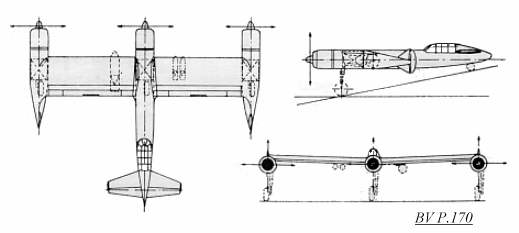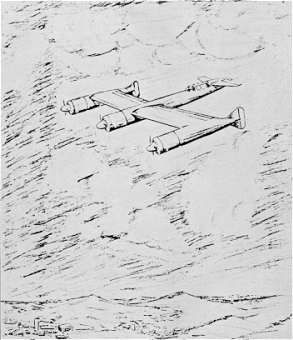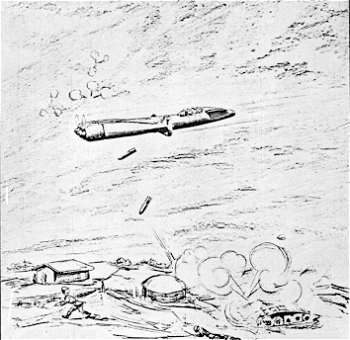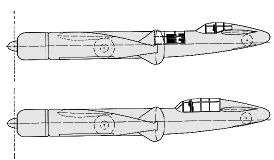Blohm & Voss BV P.170
 This fighter-bomber was designed by Dr. Vogt of Blohm und Voss in 1942,
designer of the BV 141 and other asymmetric designs. Although the BV P.170
was of a symmetrical design, it was still unorthodox in appearance. The
wing was of constant chord, and contained the ailerons and landing flaps,
which were to be constructed of wood or a light metal. Three BMW 801D radial
engines (rated at 1600 horsepower each) provided the power; each drove
a three-bladed 3.5 m (11' 5") propeller. One engine was located on the
front of the main fuselage, while the other two were mounted on wingtip
gondolas, each with a single vertical fin and rudder located at the rear.
Each engine gondola (including the center fuselage) contained a 2000 liter
(528 gallon) fuel tank, which could only feed the engine ahead of it. The
two outside engines rotated in opposite directions, to help cancel out
excessive torque. The two man crew (pilot and radio operator/ observer/
bombadier) sat in a cockpit located in the extreme rear of the center fuselage,
of which there were two main designs. A normal "tail-dragger"
undercarriage was fitted, with the exception of there being three main
landing gear legs (1015 x 380 mm wheels were to be fitted to each leg),
one located just aft of each engine. Each main landing gear leg retracted
to the rear into the engine nacelle or main fuselage. 2000 kg (4400 lbs.)
of bombs could be carried in underwing mountings.
The project's speed was thought to preclude interception, thus no defensive
armament was to be fitted.
This fighter-bomber was designed by Dr. Vogt of Blohm und Voss in 1942,
designer of the BV 141 and other asymmetric designs. Although the BV P.170
was of a symmetrical design, it was still unorthodox in appearance. The
wing was of constant chord, and contained the ailerons and landing flaps,
which were to be constructed of wood or a light metal. Three BMW 801D radial
engines (rated at 1600 horsepower each) provided the power; each drove
a three-bladed 3.5 m (11' 5") propeller. One engine was located on the
front of the main fuselage, while the other two were mounted on wingtip
gondolas, each with a single vertical fin and rudder located at the rear.
Each engine gondola (including the center fuselage) contained a 2000 liter
(528 gallon) fuel tank, which could only feed the engine ahead of it. The
two outside engines rotated in opposite directions, to help cancel out
excessive torque. The two man crew (pilot and radio operator/ observer/
bombadier) sat in a cockpit located in the extreme rear of the center fuselage,
of which there were two main designs. A normal "tail-dragger"
undercarriage was fitted, with the exception of there being three main
landing gear legs (1015 x 380 mm wheels were to be fitted to each leg),
one located just aft of each engine. Each main landing gear leg retracted
to the rear into the engine nacelle or main fuselage. 2000 kg (4400 lbs.)
of bombs could be carried in underwing mountings.
The project's speed was thought to preclude interception, thus no defensive
armament was to be fitted.
 Kevin Wafer's BV P.170 art images
Kevin Wafer's BV P.170 art images
Blohm & Voss BV P.170.01 Dimensions
| Span |
Length |
Height |
Wing Area |
16.0 m
52' 6" |
14.3 m
46' 11" |
3.65 m
12' 0" |
44.0 m²
473.6 ft² |
Blohm & Voss BV P.170.01 - Weights
| Empty Weight (Equipped) |
Crew |
Fuel |
Equipment |
Bombs |
Flying Weight |
Wing Loading |
9100 kg
20062 lbs |
200 kg
441 lbs |
2800 kg
6173 lbs |
450 kg
992 lbs |
1000 kg
2205 lbs |
13300 kg
29321 lbs |
302 kg/m²
61.9 lbs/ft² |
Blohm & Voss BV P.170.01 Performances
| Max. Speed |
Rate of Climb |
Takeoff
Speed |
Landing
Speed |
Max. Ceiling |
Range |
| @ |
0 km
0 ft |
610 km/h
379 mph |
| @ |
2 km
6562' |
675 km/h
419 mph |
| @ |
4 km
13123' |
695 km/h
432 mph |
| @ |
6 km
19685' |
760 km/h
472 mph |
| @ |
8 km
26247' |
820 km/h
510 mph |
| @ |
10 km
32808' |
715 km/h
444 mph |
|
| @ |
0 km
0 ft |
17.8 m/s
58.4 ft/s |
| @ |
2 km
6562' |
18.9 m/s
62.1 ft/s |
| @ |
4 km
13123' |
14.6 m/s
47.9 ft/s |
| @ |
6 km
19685' |
14.9 m/s
48.9 ft/s |
| @ |
8 km
26247' |
11.3 m/s
37.1 ft/s |
| @ |
10 km
32808' |
5.2 m/s
17 ft/s |
|
181 km/h
113 mph |
156 km/h
97 mph |
11650 m
38222' |
2000 km
1243 miles |
Blohm & Voss BV
P.170 Models
| Manufacturer |
Scale |
Material |
Notes |
| CzechMaster (CMK) #274 |
1/72 |
resin |
Kit models April 4, 1942 cockpit design version
Two SC 1000 bombs included |
Two drawings of the BV P.170 in action from the
original Blohm & Voss proposal to the RLM - 1942
 |
 |
Two different cockpit designs for the BV P.170

Top: design dated April 4, 1942
Bottom: design dated September 17, 1942 |
Bombloads for the BV P.170
| Normal
Load |
| Number |
Type |
Total Weight |
Location |
| 1 |
SC 1000 |
1000 kg |
under starboard wing |
| 2 |
SC 500 |
1000 kg |
one under each wing |
| 4 |
SC 250 |
1000 kg |
two under each wing |
| Over Load |
| Number |
Type |
Total Weight |
Location |
| 2 |
SC 1000 |
2000 kg |
one under each wing |
| 4 |
SC 500 |
2000 kg |
two under each wing |
|
Original Blohm & Voss
proposal
Large format 3-view drawing
of the BV P.170

The BV P.170 in winter colors as it might have appeared as a
fighter-bomber on the Eastern Front....
From ReichDreams Dossier #13, Asymmetric Planes by J. Miranda & P.Mercado
 This fighter-bomber was designed by Dr. Vogt of Blohm und Voss in 1942,
designer of the BV 141 and other asymmetric designs. Although the BV P.170
was of a symmetrical design, it was still unorthodox in appearance. The
wing was of constant chord, and contained the ailerons and landing flaps,
which were to be constructed of wood or a light metal. Three BMW 801D radial
engines (rated at 1600 horsepower each) provided the power; each drove
a three-bladed 3.5 m (11' 5") propeller. One engine was located on the
front of the main fuselage, while the other two were mounted on wingtip
gondolas, each with a single vertical fin and rudder located at the rear.
Each engine gondola (including the center fuselage) contained a 2000 liter
(528 gallon) fuel tank, which could only feed the engine ahead of it. The
two outside engines rotated in opposite directions, to help cancel out
excessive torque. The two man crew (pilot and radio operator/ observer/
bombadier) sat in a cockpit located in the extreme rear of the center fuselage,
of which there were two main designs. A normal "tail-dragger"
undercarriage was fitted, with the exception of there being three main
landing gear legs (1015 x 380 mm wheels were to be fitted to each leg),
one located just aft of each engine. Each main landing gear leg retracted
to the rear into the engine nacelle or main fuselage. 2000 kg (4400 lbs.)
of bombs could be carried in underwing mountings.
The project's speed was thought to preclude interception, thus no defensive
armament was to be fitted.
This fighter-bomber was designed by Dr. Vogt of Blohm und Voss in 1942,
designer of the BV 141 and other asymmetric designs. Although the BV P.170
was of a symmetrical design, it was still unorthodox in appearance. The
wing was of constant chord, and contained the ailerons and landing flaps,
which were to be constructed of wood or a light metal. Three BMW 801D radial
engines (rated at 1600 horsepower each) provided the power; each drove
a three-bladed 3.5 m (11' 5") propeller. One engine was located on the
front of the main fuselage, while the other two were mounted on wingtip
gondolas, each with a single vertical fin and rudder located at the rear.
Each engine gondola (including the center fuselage) contained a 2000 liter
(528 gallon) fuel tank, which could only feed the engine ahead of it. The
two outside engines rotated in opposite directions, to help cancel out
excessive torque. The two man crew (pilot and radio operator/ observer/
bombadier) sat in a cockpit located in the extreme rear of the center fuselage,
of which there were two main designs. A normal "tail-dragger"
undercarriage was fitted, with the exception of there being three main
landing gear legs (1015 x 380 mm wheels were to be fitted to each leg),
one located just aft of each engine. Each main landing gear leg retracted
to the rear into the engine nacelle or main fuselage. 2000 kg (4400 lbs.)
of bombs could be carried in underwing mountings.
The project's speed was thought to preclude interception, thus no defensive
armament was to be fitted.



